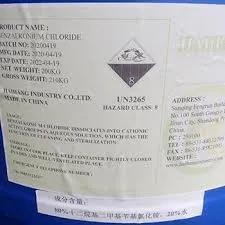hydrolyzed polyacrylamide
Hydrolyzed Polyacrylamide An Overview
Hydrolyzed polyacrylamide (HPAM) is a water-soluble polymer derived from polyacrylamide through the process of hydrolysis. It has gained significant attention in various industries due to its unique properties that make it versatile for numerous applications. The structure of HPAM consists of acrylamide units that can be partially hydrolyzed, resulting in carboxylic groups that confer ionic characteristics to the polymer. This modification enhances its solubility in water and allows it to interact with a variety of ions and molecules.
One of the primary applications of hydrolyzed polyacrylamide is in the oil and gas industry, where it is utilized as a viscosity modifier and a thickening agent in enhanced oil recovery (EOR) techniques. By increasing the viscosity of water injected into oil reservoirs, HPAM helps to improve oil displacement and extraction efficiency. This is particularly important in mature fields where conventional extraction methods have become less effective.
In addition to its role in EOR, HPAM is widely used in water treatment processes. Its ability to flocculate and coagulate makes it an important agent in the purification of wastewater. During this process, HPAM helps to agglomerate suspended particles, which can then be easily removed, leading to cleaner water outputs. This application is especially relevant in industries where water quality is critical, such as food processing, pharmaceuticals, and chemical manufacturing.
hydrolyzed polyacrylamide

The agricultural sector also benefits from hydrolyzed polyacrylamide
. It is employed as a soil conditioner to improve soil structure, enhance moisture retention, and reduce erosion. By modifying the physical properties of the soil, HPAM helps to create a more favorable environment for plant growth, particularly in arid regions where water scarcity is a significant challenge.Moreover, hydrolyzed polyacrylamide is explored for its potential applications in the biomedical field. Its biocompatibility and tunable properties make it a candidate for drug delivery systems and tissue engineering. Researchers are investigating HPAM-based hydrogels to develop innovative therapies that can release drugs in a controlled manner or provide scaffolding for tissue regeneration.
Despite its many advantages, there are ongoing discussions regarding the ecological impact of hydrolyzed polyacrylamide. As with any synthetic polymer, it is crucial to assess its long-term effects on the environment and human health. Sustainable practices, such as responsible sourcing and end-of-life management, are essential to mitigate any potential risks associated with its use.
In summary, hydrolyzed polyacrylamide is a multifunctional polymer with a broad range of applications across various industries, including oil and gas, water treatment, agriculture, and biomedicine. As research and development continue, HPAM is poised to play an increasingly important role in addressing the challenges faced by these sectors while promoting sustainability.
-
LK-319 Special Scale And Corrosion Inhibitor For Steel Plants: Advanced Solutions for Industrial Water SystemsNewsAug.22,2025
-
Flocculant Water Treatment: Essential Chemical Solutions for Purification ProcessesNewsAug.22,2025
-
Isothiazolinones: Versatile Microbial Control Agents for Industrial and Consumer ApplicationsNewsAug.22,2025
-
Scale Inhibitor: Key Solutions for Water System Scale PreventionNewsAug.22,2025
-
Organophosphonates: Versatile Scale Inhibitors for Industrial Water SystemsNewsAug.22,2025
-
Scale and Corrosion Inhibitor: Essential Chemical Solutions for Water System MaintenanceNewsAug.22,2025





